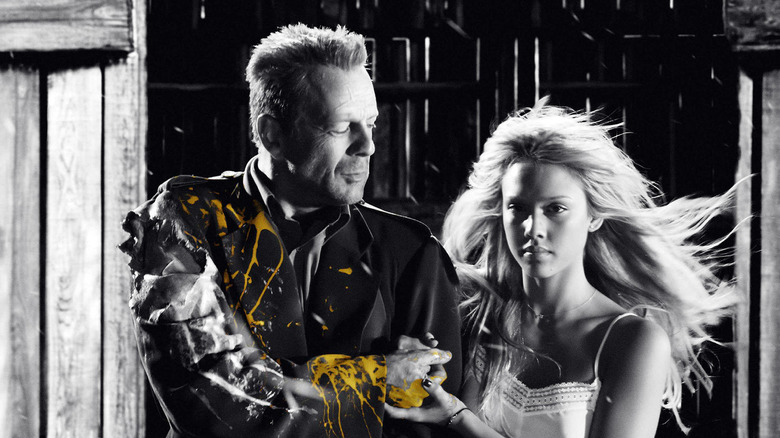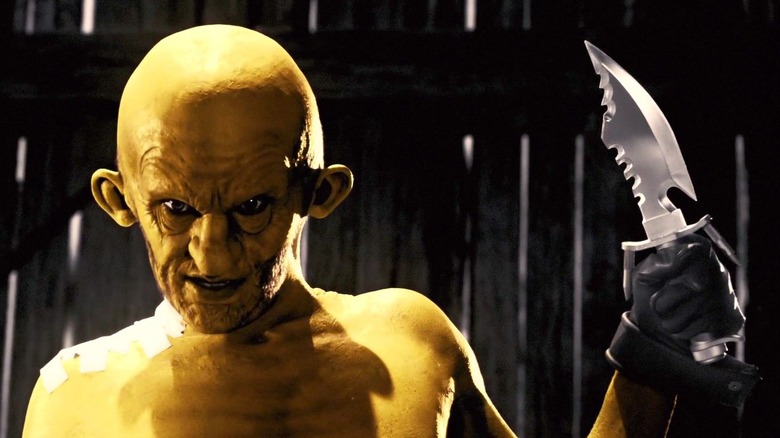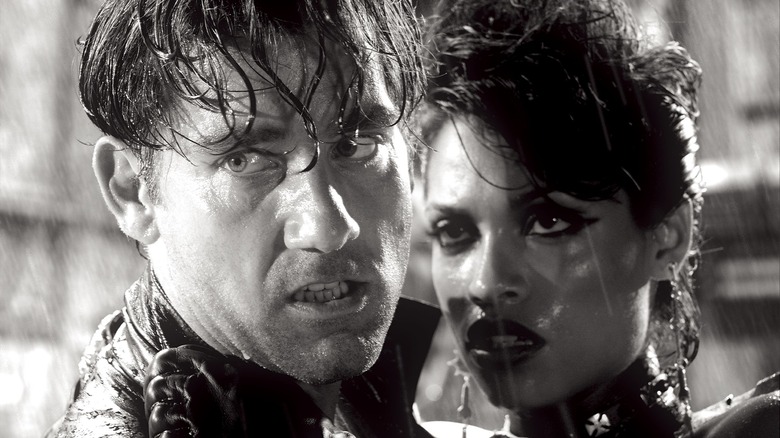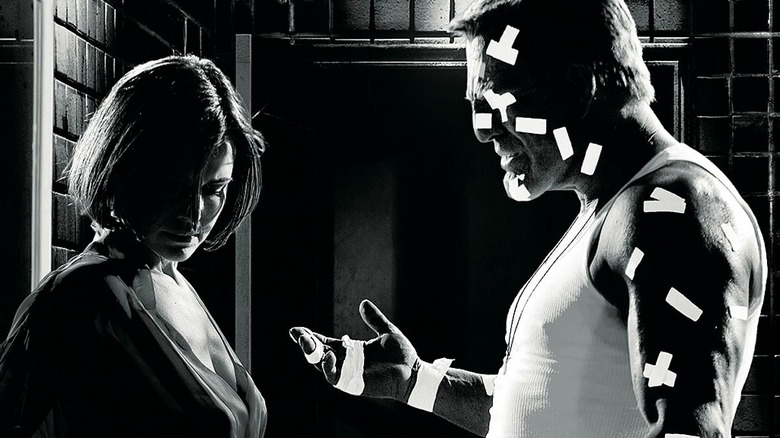Few Directors Followed In Sin City's Footsteps, And Cinema Is Poorer For It
Comic book movies are everywhere. At the beginning of the millennium, comic and graphic novel adaptations were uncommon, with the critical failure of "Batman and Robin" putting the breaks on many studios' plans for future superhero fare. Nowadays, we are spoiled by the veritable bounty of comic book re-imaginings, from the indomitable machine of the Marvel Cinematic Universe to the many spin-offs of "The Walking Dead" to the Oscar-winning success of "Joker." We live in a time where even "Madame Web" is getting a big-budget film. Truly, our cup runneth over.
Of course, the trend is currently for superheroes and hasn't expanded much beyond that limited subgenre. Comic books are like any other artistic medium: they encompass seemingly limitless potential across styles, themes, genres, and intents. There are exceptions, from the mundane realism of "Ghost World" and "American Splendor" to the rip-roaring golden age adventuring of "The Adventures of Tintin." Alas, these examples are few and far between, especially when compared to their caped contemporaries. It seems like a wasted opportunity, to not bring the richness of creators like Brian K. Vaughan's "Saga" or the melancholy of Craig Thompson's "Blankets" to the screen. Comic books for adults, tackling themes and concerns of audiences not in the key Disney demographic, are aching to be given such lavish adaptations. In hindsight, it makes the major success of "Sin City" feel like an even bigger surprise than it was when released in 2007. It also makes its lack of cultural footprint all the more surprising.
Adapting Sin City was a major risk
Of all the comics in the world, "Sin City" was never seen as the most probable to receive Hollywood's attention. The infamous Frank Miller, who rose to fame in the '80s with his work on "Daredevil" and "The Dark Knight Returns," wanted to explore his love of old crime novels and classic film noir. As he explained in an interview in 2016, he wanted to create "a world out of balance, where virtue is defined by individuals in difficult situations, not by an overwhelming sense of goodness that was somehow governed by this godlike Comics Code." Fittingly, Miller's "Sin City" is stark, bleak, and devoid of anyone who could even remotely be considered heroic. The crisp black and white artwork, occasionally punctuated by splashes of color, takes the shadows of classic noir to their most brutal conclusion. Basin City is populated by corruption, sexual exploitation, gun-toting sex workers, and warring crime families. There is shocking violence, rape, child abuse, and genital mutilation, the kind of stuff that classic noir stridently avoided in the age of the Hays Code. To put it bluntly, "Sin City" is anti-Hollywood.
Director Robert Rodriguez had long been a fan of Miller's work. Having gotten his start with the micro-budget neo-Western "El Mariachi", he then spent the next decade veering between stylized action films, pulpy genre fare, and imaginative family-friendly titles with the "Spy Kids" series. While making the "Spy "Kids" movies, he fell in love with the potential offered by green-screen and CGI in the filmmaking process. In Roger Ebert's review of the film, he recalled a speech Rodriguez gave on-set of "Spy Kids 2: The Island of Lost Dreams", where he declared, "This is the future! You don't wait six hours for a scene to be lighted. You want a light over here, you grab a light and put it over here. You want a nuclear submarine, you make one out of thin air and put your characters into it." Miller's "Sin City" felt like the perfect material for him to further explore this new territory, and to bring the comics to light in a very literal manner.
Sin City is extremely faithful to the source material
To say that "Sin City" sticks closely to the source material (in this case three separate stories that intertwine through the course of the movie) would be an understatement. Rodriguez himself said the film was more a "translation" of the graphic novels than a traditional adaptation. There's not even a screenwriting credit because of this, with the film simply being listed as "based on the graphic novels by Frank Miller." The movie is, almost entirely, a shot-for-shot adaptation of the comics, from the dialogue to shot compositions to the grit of the buildings (the only major change is that there are far fewer nipples on display, since Miller's vision of a world where women never wear clothes is decidedly not MPAA-friendly.) Watching the film if you've read the comics is a surreal twinning experience, one with few similar examples in film. To achieve this strident faithfulness to Miller's work, Rodriguez brought him in as co-director. This move led him to leave the Directors Guild of America after they wouldn't allow the pair to be credited as a team.
It's in the visuals where "Sin City" stands tall and remains unique among the competition. In his review of the film for the Sun-Sentinel, Chauncey Made wrote, "Really, there will be no reason for anyone to make a comic-book film ever again." After being consumed by "Sin City," you almost believe him. Even 15 years after its release, this film still looks stunning in its anti-realist interpretation of the tropes of film noir. The anti-realist sharp white splatter of blood (and yellow in one gloriously repulsive instance) feels just as shocking as it would have in red. The city embodies various decades of aesthetics, from the cars to the costumes. While there's a flatness to scenes that evokes Miller's comics, it's not without the richness of depth that film revels in, particularly in fight scenes (of which there are many.) Every frame is visually uncompromising, in total rejection of the grimdark realism that would become the default mode for modern American superhero cinema. The real world doesn't look like this, doesn't sound like this, doesn't move like this. People don't have faces like those of Mickey Rourke's Marv or the stomach-churning Yellow Bastard. In one scene, a man taunts his killer while he has a pistol stuck in his head. There are downsides to this, such as Miller's notorious misogyny rearing its ugly head with literally every female character. They're all overtly sexualized, with most of them being punching bags for the amoral men in their lives, and sometimes it's tough to stomach.
Why didn't Sin City inspire Hollywood?
While "Sin City" has a relatively minor cinematic legacy, it is not bereft of clout. From a $40 million budget, it grossed over $158.7 million worldwide, proving the might of the R-rated movie in a year where Harry Potter and Narnia were dominant. The use of green-screen instead of sets and traditional production design did become the primary force of filmmaking in the ensuing years, as any behind-the-scenes image of a Marvel production can testify. Yet those movies aim to use CGI for realism rather than anything more abstract or comics-based in style. In terms of more obvious copycats, the progeny of "Sin City" couldn't strike gold twice. Frank Miller solo-directed an adaptation of "The Spirit", which failed miserably thanks to his lack of basic directorial prowess and a screenplay that read like a parody of the Miller noir style. Even the eventual "Sin City" sequel, 2014's "A Dame to Kill For," just couldn't recapture the magic.
The ultraviolence and hyper-unreal nature of "Sin City" never lent itself well to the burgeoning comic book adaptation mold of 21st-century Hollywood. The R-rated film isn't dying so much as it's clearly been overshadowed by the family-friendly blockbuster, those too-big-to-fail IP ventures with expanded universes of narratives and uncomplicated worldwide appeal. The industry sees comics as kids' fare, a few exceptions aside, and that's not really changed as the Marvel stranglehold over the medium has increased. The comic book movie formula has been fine-tuned into its current form, and it will remain that way until it becomes unviable to do so (the long-anticipated backlash hasn't quite hit yet, although dwindling box office receipts for the likes of "Black Adam," "Shazam! Fury of the Gods," "and "Ant-Man and the Wasp: Quantumania" might speed up the process.) The likes of "Sin City" will forever be outliers, not simply because of their content but their style. It's a shame because it should have opened up the industry to embracing the true limitlessness of comic books, visually and thematically. For an entire decades-old medium and its myriad possibilities to be reduced to one sliver of superhero fare with identical visuals feels like a startlingly unambitious view of the artform. Perhaps it's time to dive headfirst back into the realms of the unreal.



